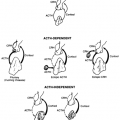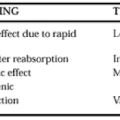MORPHOLOGY AND PHYSIOLOGY OF THE OVARY
Gregory F. Erickson
James R. Schreiber
Under normal conditions, women produce a single dominant follicle that participates in a single ovulation each menstrual cycle. The process begins when a cohort of primordial follicles is recruited to initiate growth. Successive recruitments give rise to a pool of growing follicles (i.e., primary, secondary, tertiary, graafian) in the ovaries. The ability to become dominant is not a characteristic shared by all follicles, and those that lack the property die by atresia. In the human female, only ˜400 of the original 7 million follicles survive atresia. Recognition that only a few follicles survive and ovulate their eggs demonstrates the principle that folliculogenesis in mammals is a highly selective process.
After the dominant follicle ovulates its ovum, the follicle wall develops into a corpus luteum by a process called luteinization. If implantation does not occur, the corpus luteum is destroyed by luteolysis. This chapter reviews the structure of the various histologic units in the ovary, and analyzes the mechanisms that cause them to change during the menstrual cycle.
Stay updated, free articles. Join our Telegram channel

Full access? Get Clinical Tree





